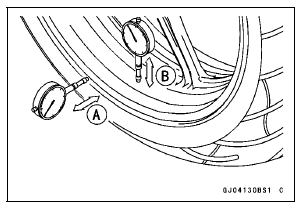

Special Tools - Jack: 57001-1238 Jack Attachment: 57001-1608

If roughness or binding is found, replace the hub bearings (see Hub Bearing Removal/Installation).
If there is any damage to the wheel, replace the wheel.
If rim runout exceeds the service limit, check the hub bearings (see Hub Bearing Inspection).
If the problem is not due to the bearings, replace the wheel.
Rim Runout (with tire installed) Standard: Axial TIR 0.5 mm (0.02 in.) or less
Radial TIR 0.8 mm (0.03 in.) or less
Service Limit: Axial TIR 1.0 mm (0.04 in.)
Radial TIR 1.0 mm (0.04 in.)
| WARNING Damaged wheel parts may fail and cause an accident resulting in serious injury or death. Never attempt to repair a damaged wheel part. If the wheel part is damaged, it must be replaced with a new one. |
 Rear Wheel Installation
Rear Wheel Installation Axle Inspection
Axle InspectionRebound Damping Force Adjustment
The rebound damping force adjuster
is located at the upper end of the rear
shock absorber.
A. Rebound Damping Force Adjuster
B. To increase damping force
C. To decrease damping force
Using a screwdriver turn the rebound
damping force adjuster clockwise
to increase rebound damping or ...
Intake Air Pressure Sensor #1 Output Voltage Inspection
Measure the output voltage at the intake air pressure sensor
#1 in the same way as input voltage inspection, note
the following.
Disconnect the intake air pressure sensor #1 connector
and connect the measuring adapter [A] between these
connectors.
[B] Main Harness
[C] Intake Air Pressu ...
Stick Coil Installation
Apply a thin coat of grease [A] to the stick coils for easy
installation.
Insert the stick coils so that the coil heads align with the
lines [B] on the cylinder head cover.
NOTICE
Do not tap the coil head while installing the coil.
After installation, be sure the stick coils are ...